Wednesday, December 21, 2011
Thursday, December 1, 2011
Monday, November 28, 2011
Thursday, November 24, 2011
Monday, October 3, 2011
Bald Eagles
I'm lucky enough to have a tall tower near my home giving the raptors a clear view of the field below.
Sunday, September 4, 2011
Mr. Bear went to the doctor
I got an infection in my tail,it was driving me crazy,so I tried chewing.Dad saw me chewing it and that was all it took for a visit to my buddy Dr. Vet...nice human.
Meds are OK, cause I get some peanut butter,along with the cap,Dad thinks I don't know it is there...:-)))
But that cone thing will not work.....I gave Dad the Big eyes,sad look and off it came...if I chewed things it would be gone.
So now morning and night Dad sprays my shaved area,and I get 2 clumps of peanut butter.
I'm on the mend.
Saturday, June 25, 2011
Wednesday, April 27, 2011
Nature's way
Thursday, April 7, 2011
BAD Hair day
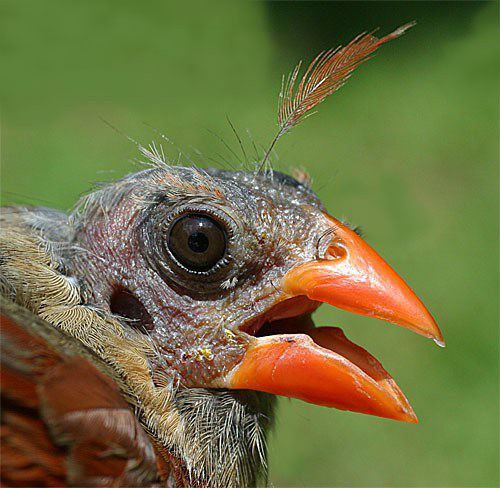
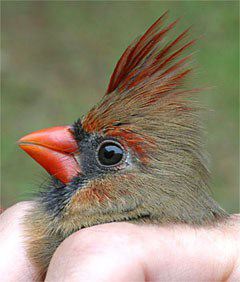 She has lost all but one of the feathers in what should normally be an elegant crest (below right), and she now looks for all the world like some kind of naked lizard-head mounted on the red-feathered body of a bird.
She has lost all but one of the feathers in what should normally be an elegant crest (below right), and she now looks for all the world like some kind of naked lizard-head mounted on the red-feathered body of a bird.If anyone has any doubt that birds and dinosaurs sprang from a common ancestor, even a cursory look at the top photo should convince them otherwise. The cardinal's ear opening and lack of an ear flap are just like that of a lizard, and the only real external differences between their heads is that lizards such as male Carolina Anoles (below left) have scales and toothy, bony jaws while birds have unscaled skin and toothless, horny bills. (NOTE: Having just experienced the pain that comes from a Northern Cardinal repeatedly clamping down on our finger while we took these photos, we might rather be bitten by a lizard with teeth.)
All birds go through molt, and most species replace all their feathers at least twice a year. In some birds winter plumage is very different from breeding attire, while other birds look pretty much the same year-round. Here in the Carolina Piedmont, Northern Cardinals normally replace their worn and dingy body feathers--including those on their heads--starting in mid-summer after breeding is done.
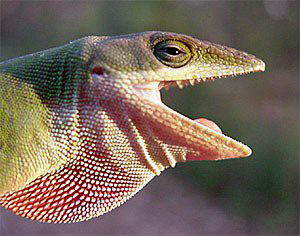 Typically they lose and bring in new feathers a few at a time, lest they end up being naked and completely unprotected from the elements. Thus, it's not unusual to see a male or female cardinal looking a bit ratty this time of year, missing a few plumes in its crown here, a tail feather or two there. What IS unusual is to find a bird with its entire tail gone or--worse yet--a head absolutely devoid of plumage. We get several e-mails or phone calls each year about this phenomenon, and folks always seem relieved to learn that instead of having some sort of alien mutant glow-in-the-dark lizard-bird at their feeders, it may be that they have a cardinal or Blue Jay or Eastern Towhee with a bad case of head mites. If a bird is infested with these little critters, it wouldn't be surprising for it to scratch continuously until many or all feathers within reach of the claws were worn off.
Typically they lose and bring in new feathers a few at a time, lest they end up being naked and completely unprotected from the elements. Thus, it's not unusual to see a male or female cardinal looking a bit ratty this time of year, missing a few plumes in its crown here, a tail feather or two there. What IS unusual is to find a bird with its entire tail gone or--worse yet--a head absolutely devoid of plumage. We get several e-mails or phone calls each year about this phenomenon, and folks always seem relieved to learn that instead of having some sort of alien mutant glow-in-the-dark lizard-bird at their feeders, it may be that they have a cardinal or Blue Jay or Eastern Towhee with a bad case of head mites. If a bird is infested with these little critters, it wouldn't be surprising for it to scratch continuously until many or all feathers within reach of the claws were worn off.This week's discussion of bald cardinals and head mites may have you subconsciously scratching your own scalp by the time you get to the end of this essay, but you probably don't have to worry about getting mites from birds--unless you have a bunch of House Sparrows, Rock Doves, or some native colonial bird species nesting in the attic above your bed. Birds actually host a great many kinds of mites, but most of these little parasites aren't interested in sucking human blood; they may inflict test bites on people, but they seldom hang on for a real meal. When they do, however, they can cause serious discomfort and are even suspected of being vectors of debilitating disease.
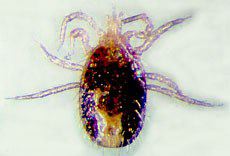 Mites resemble ticks in structure but are far smaller; many are tiny enough to fit on the head of a pin with room to spare, and some must be viewed with at least a low-power microscope to be seen at all. Their larvae usually have three pairs of legs; as nymphs, most gain a fourth pair that is retained in the adult stage (right). Mouth parts on typical mites are adapted for piercing the integument of their hosts; species that live on people can cause intense itching that apparently results from allergic reaction to the mites' metabolic waste products. Scab Mites (which cause "scabies") and Mange Mites are among the most common parasites of domesticated animals and their owners, while House Dust Mites live in our bed sheets, dining on the unending supply of dead skin cells shed from our bodies.
Mites resemble ticks in structure but are far smaller; many are tiny enough to fit on the head of a pin with room to spare, and some must be viewed with at least a low-power microscope to be seen at all. Their larvae usually have three pairs of legs; as nymphs, most gain a fourth pair that is retained in the adult stage (right). Mouth parts on typical mites are adapted for piercing the integument of their hosts; species that live on people can cause intense itching that apparently results from allergic reaction to the mites' metabolic waste products. Scab Mites (which cause "scabies") and Mange Mites are among the most common parasites of domesticated animals and their owners, while House Dust Mites live in our bed sheets, dining on the unending supply of dead skin cells shed from our bodies.Although taxonomy of mites is under debate, many authorities place them in the Acari, a large arthropod order that includes Ticks. Mites are arranged differently by various taxonomists but usually include several discrete families, including the Harvest Mites or Chiggers (Trombiculidae), Itch Mites (Sarcoptidae), and Follicle Mites (Demodicidae, miniscule organisms that live in lashes and sebaceous glands of the human eye); all these parasitize people--or at least scavenge thereupon--but Bird Mites (Dermanyssidae) pretty much stick to avian hosts. Water Mites (Hydrachnidae) have fringed legs adapted for swimming and inhabit freshwater rivers and lakes where they prey upon macroinvertebrates, while four-legged Spider Mites (Tetranychidae) spin miniature webs on the undersides of leaves, where they suck sap and sometimes cause galls or kill host plants. Hummingbirds are even known to transport plant mites from flower to flower as they sip nectar and help cross-pollinate.
Bird Mites are usually thought of as skin parasites; some species are more specialized and inhabit esoteric locales such as a bird's air sacs or crevices between the scales on its legs.
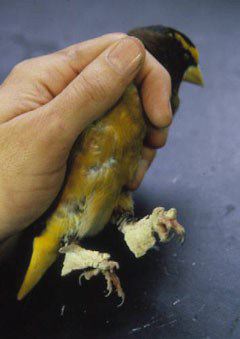 Occasionally at Hilton Pond Center we capture a bird with a case of "scaly-leg" so bad that we have to forego banding the bird. The absolute worst infestation of leg mites we've encountered was on a male Evening Grosbeak in Minnesota; pinkish-yellow wing-like crustiness covered the entire length of both legs (left). This condition almost certainly affected the grosbeak's behavior, and--as with other kinds of arthropod parasites--Scaly-leg Mites may have had potential to eventually kill the host.
Occasionally at Hilton Pond Center we capture a bird with a case of "scaly-leg" so bad that we have to forego banding the bird. The absolute worst infestation of leg mites we've encountered was on a male Evening Grosbeak in Minnesota; pinkish-yellow wing-like crustiness covered the entire length of both legs (left). This condition almost certainly affected the grosbeak's behavior, and--as with other kinds of arthropod parasites--Scaly-leg Mites may have had potential to eventually kill the host.It's not clear to us whether shiny-pate Northern Cardinals can die directly because of baldness, but complete loss of head feathers seems likely to cause stress in a bird. A bald-headed cardinal won't fare very well on a cold, rainy day, and all that bare skin is exposed to mosquito bites that these days could lead to West Nile Virus. Perhaps more important, researchers have found that potential mates don't respond favorably to birds with aberrant plumage; thus, a naked head instead of a feathery crest might mean a mite-laden bird wouldn't get a chance to breed and pass on its genes. In the case of this week's lizard-headed Northern Cardinal female, a well-developed incubation patch indicates she is or has been sitting on either eggs or nestlings, but she probably won her suitor's eye well before losing all her head plumage. If she's carrying mites, there's now a good chance she'll share her parasite collection with her offspring.
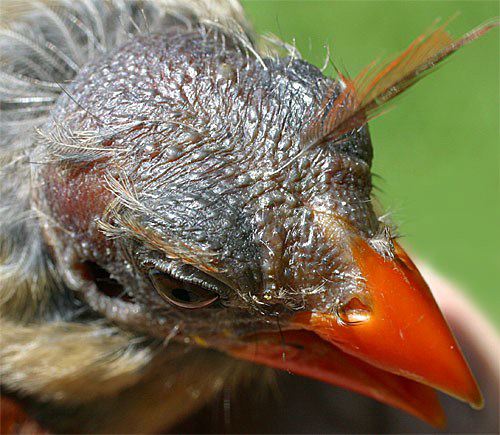 All text & photos © Hilton Pond Center
All text & photos © Hilton Pond CenterCAVEAT #1: It's worth noting that some authorities believe the simultaneous loss of head feathers in wild birds may be due to factors other than or in addition to mites and the scratching behavior that results from infestation. Factors might include nutritional deficiencies, high temperature, or other environmental stress; it's even possible total feather loss may be a normal occurrence for individual birds. We also caught a male Northern Cardinal this week that was half-bald and infested with feather lice, so there actually may be other parasites that cause or add to the baldness. One other interesting note is that some bird mites only inhabit the host for short periods of blood-sucking before hiding in the nest for the remainder of the day; thus, a bird affected by mites might not actually be carrying them when it is captured during the banding process and would show no direct evidence of being infested by the parasite. The whole phenomenon is worthy of further study.
POSTSCRIPT #1: Dr. Jim Philips (Babson College), who studies mites, responded to our info above by saying "I would not expect your mites to be dermanyssids--they suck blood but don't directly cause feather loss. Burrowing skin mites--Harpyrhynchidae or Knemidocoptidae or Epidermoptidae--cause feather loss directly, in a fashion similar to the way mange mites cause fur loss in mammals." Some banders have wondered why mites that cause baldness in birds can't be seen when the bird is in-the-hand; Dr. Philips' explanation suggests that the mites could be embedded in the skin and would not be easily detected. However, he also cautioned that follicle mites have NOT been collected and identified from bald birds.
POSTSCRIPT #2: On 2 May 2004 we retrapped a male Northern Cardinal (#8101-40966) that had been banded at Hilton Pond Center as a recent fledgling on 8 July 2002. At recapture, this bird exhibited baldness very similar to that depicted in the female cardinal in the photos above. Cardinals do not typically undergo head molt this early in the season; in fact, most bald cardinals show up in mid-summer when some have suggested that loss of head feathers could be part of the normal molt process. A bald cardinal in early May seems to undermine that supposition and implies some other factor(s) might be involved. (NOTE: This individual was also recaptured locally on 09/18/02, 12/12/02, 06/02/03, and 07/07/03; it had normal head feathering on all those dates.)
POSTSCRIPT #3: Northern Cardinal #8101-40837, the female in the photos above, was recaptured on 10/27/03 with no sign of baldness.
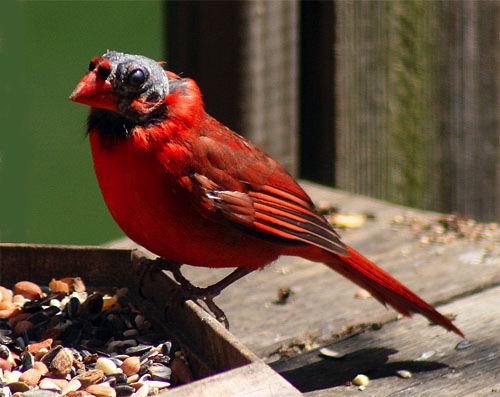
All text & photos © Hilton Pond Center
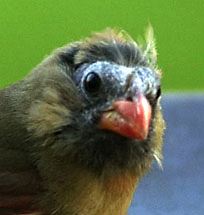 In this photo the bird's nictitating membrane (transparent "third eyelid") completely covers the eye, making it look somewhat gray; the membrane is retracted in other photos from Debbie.
In this photo the bird's nictitating membrane (transparent "third eyelid") completely covers the eye, making it look somewhat gray; the membrane is retracted in other photos from Debbie.On 20 April 2007 we received another photo (left)--this time of a female cardinal coming to a feeder at the home of Cathy and Tracey Trumbull, who live within a mile of the Schweinbergs. This bird showed partial baldness that likely is caused by mites rather than a "normal" molt. TheTrumbulls also reported a bald male cardinal that could be the same bird photographed by Debbie Schweinberg.
Credits to Hilton Pond Center
Monday, March 28, 2011
Sunday, March 27, 2011
Saturday, March 19, 2011
Moon perigee...March 19, 2011
The supermoon event is said to occur between March 16 and March 22 with the full moon taking place on March 19.
Celestial bodies do not orbit in perfect circles as the earliest scientist thought. Johannes Kepler showed us in 1609 that planets and moons sweep out their orbits in ellipses. This means that, at some points in their orbits, they are closer to the body they orbit than other points. Whenever a celestial satellite is at its closest point, it is known to be at perigee and when it is at its furthest point from the body it orbits, it is at apogee.
Even though this Saturday’s full moon occurs within an hour of the perigee, the satellite is still 356,577 kilometers away from Earth, only about 8 percent closer than its average distance from Earth. This full moon at perigee is a super moon and will appear about 14 percent bigger and 30 percent brighter than lesser moons that occur on the apogee side of the moon's orbit.
The best time to look is when the moon is near the horizon at moon rise in the east and moon set in the west. When the moon is near the horizon, illusion mixes with reality to produce an amazingly large view of the moon. For reasons not completely understood by scientist, moons hanging just above the horizon look unnaturally large when they are seen between trees, buildings and other foreground objects.
Check out Saturday morning’s moon set, but do it before it hits the horizon around 6:30 am. The actual full moon will occur during the daylight hours on Saturday, so the next best time will be right around 7 pm on Saturday after the moon rise. Sunday morning before daybreak will also afford a quality view, but by Sunday evening, the moon will be starting its trip back toward apogee.
A perigee full moon brings with it extra-high "perigean tides," but this is nothing like the natural disasters predicted by Internet doomsayers. The only impact of a slightly closer moon will be slightly higher tides. In most places, lunar gravity at perigee pulls tide waters only about an inch or so higher than usual.
Sunday, March 13, 2011
Sunday, March 6, 2011
County Dog Parks
Pinellas County Dog Parks | |||||||||
|
Thursday, March 3, 2011
Film or digital..from article at Beyond Megapixels ( great read by the way)
Beyond Megapixels |
A woman that works in my office loves nature and nature photography. Because of our common interest she and I talk about photography from time to time. What’s a little different about her approach to photography is that she shoots with film exclusively and doesn’t own a DSLR. She wants to buy a DSLR but doesn’t think she can afford it right now.
This got me to thinking about the costs of photography and I decided to write this article comparing the costs between film and digital photography. It isn’t intended to cover every cost but just enough to provide a comparison.
To go digital the first big expense she would have to face is the cost of the DSLR camera and new lenses. While it’s a significant capital outlay, it’s a crossover cost and similar for either format so I didn’t include this cost in the comparison.

When you take a photo it is stored someplace, either on the light sensitive film or on a memory storage device and a comparison of film and memory seemed like a good place to start. My camera, a Canon 7D, uses Compact Flash and when shooting in RAW my 16GB Sandisk Extreme 60 MB/s UDMA card will store 640 25MB images. I can fill the card, download the images and format the card to use it again. If I do this three times I will have 1,920 images and will still have the card to use again. Depending on where you purchase the card, the cost is roughly $92. At 1,920 images that figures out to be just under $0.05 per image and each time I use the card again, the per-image cost goes down.

My co-worker uses Ektar 100 36 exposure 35mm color film. The cost per roll is 4.49 and processing (not including printing) is about $6.50, depending on where you have it processed. That is $0.305 per image and is a fixed cost whether you take 1 roll or 1,000 rolls. Fifty-four rolls of film would produce 1,944 images with a total cost of approximately $594.00. Last year I took about 6,000 images and if I were using film I would have spent close to $2,000 on film and processing for the same number of images. Depending on how many images she takes in a year, it wouldn’t take her very long to pay for a new DSLR with what she would be saving on film.
I gave her this information and she quickly pointed out that she would have to buy all that special software like Photoshop. That’s true to a point. Once I’ve taken the photos with my DSLR I can download the images to my computer using the software that was included with my camera when I purchased it. I can’t do anything with it but I have the image. This is the same as the film image you have after processing except with film you have a negative. If I want to make any modifications to the image it requires some sort of photo manipulation software. I could use Corel, iPhoto or some other economic photo manipulation software. I could, but I don’t.
The cost of the software isn’t inexpensive but there isn’t much I can’t do with an image. I have the following programs that can be purchased on Amazon at the indicated cost:
Photoshop CS5 – $689
Lightroom 3 – $244
Nik Software Complete Collection – $500
All this comes to a shocking total of $1,432.71 and I still want to get Photomatix for HDR work. Fortunately, because of discounts and special offers I didn’t pay that much for the software but it was still a big number.
The obvious argument is you can have a lot of photos printed for $1,500 and the cost of all this expensive software makes digital photography at least as expensive as film.
I think this argument is incorrect for a couple of reasons. First, the software cost is a one time cost (not counting upgrades) and with every image the per-image cost is reduced. With the cost of film and developing the cost of printing is the same for every image printed and the per-image cost isn’t affected. Second, if you just have the images printed and no other processing done with the images you still have a straight out of camera (SOOC) image which isn’t any different than you would have if you printed one of your digital images on your desktop ink jet printer without any software manipulation.

I view all this software the same as I would a darkroom if I was still involved with film photography. Determining the cost of a darkroom isn’t as easy as adding the price of software but the largest single expenditure is easy to find. If I built a darkroom I would want the Beseler 23CIII-XL Dichroic (Color) Enlarger. A new one at B&H Photo costs $1,224.95. Then you would have to buy all the trays, tanks, reels, clips, tongs, etc., none of which are expensive but when you add them all together it would be a few hundred dollars. There are less expensive enlargers on the market, especially if black & white is all you want to do, and you can find used enlargers for less than the cost of a new one. However, if you want the same capability in a dark room as you have with digital processing you kind of have to go all out.
You also have to have a dark room and most houses don’t come equipped with them. I know that some people set up temporarily in a bathroom or a closet but I can think of two major problems with that approach. I don’t want to set up and take down every time I want to develop photos and my wife would veto any attempt to use a closet or a bathroom and I don’t blame her. That means you would have to figure in the cost of building a dark room as well.
My conclusion is that as expensive as digital photography can be and as heart palpitating as the cost of some equipment and software is, in the end it’s still less expensive than film photography approached at the same level. Now I feel so much better about the money I’m spending on this wonderful endeavor called photography.
As a footnote, for those looking to shoot holes in my logic, I didn’t include the cost of a computer because I’ve had home computers for longer than digital photography has been widely available.
Photo Credits:
Compact Flash Card by MiNe (sfmine79) on Creative Commons
Kodak Ektar 100 Film by lonnie127 on Creative Commons
Beseler Enlarger by Nesster on Creative Commons
Monday, February 7, 2011
AKC NEW REGISTERED BREEDS
Entlebucher Mountain Dogs
 The Entlebucher (pronounced Ent-lay-boo-cur) Mountain dog, a member of the Herding Group of the AKC, is named after a small town in Switzerland, Entlebuch. It is the smallest of the Swiss Mountain dogs and a sturdy dog with lively eyes and a drive to work. They are believed to have descended from Roman mastiffs. This breed is bred to work, so daily exercise is absolutely needed. They need a firm but calm pack leader and are very eager to please. They are small and often do not exceed 60 lbs.
The Entlebucher (pronounced Ent-lay-boo-cur) Mountain dog, a member of the Herding Group of the AKC, is named after a small town in Switzerland, Entlebuch. It is the smallest of the Swiss Mountain dogs and a sturdy dog with lively eyes and a drive to work. They are believed to have descended from Roman mastiffs. This breed is bred to work, so daily exercise is absolutely needed. They need a firm but calm pack leader and are very eager to please. They are small and often do not exceed 60 lbs. How are they as pets?
Entlebuchers are very social and love being around people and other dogs but can be aloof with strangers. Socialize them and they will be more receptive to meeting strangers. They do require a lot of exercise and can live from 11 to 15 years. Grooming them is not tough, just brush them regularly to remove debris and build up of dander. They need space to run and play. An apartment is not ideal for this breed unless you jog a lot and can take your pup with you! Entles thrive when they have a “job.”
Norwegian Lundehund
 Also known as the Norwegian Puffin Dog, the Lundehund is a spitz and one of the world’s oldest breeds. They have six toes on each foot, 2 dewclaws and is an excellent climber. Their unique vertebral structure allows them to look virtually 180 degrees over their heads, able to practically rest their heads on their backs. They have very animated ears that can point in more directions than most other dog breeds. They are friendly by nature and like meeting people and do not have aggressive tendencies if bred correctly. They are curious and will explore the world about them so being on leash outside is a must.
Also known as the Norwegian Puffin Dog, the Lundehund is a spitz and one of the world’s oldest breeds. They have six toes on each foot, 2 dewclaws and is an excellent climber. Their unique vertebral structure allows them to look virtually 180 degrees over their heads, able to practically rest their heads on their backs. They have very animated ears that can point in more directions than most other dog breeds. They are friendly by nature and like meeting people and do not have aggressive tendencies if bred correctly. They are curious and will explore the world about them so being on leash outside is a must. How are they as pets?
These are quite affectionate, playful dogs that love people and other canines. Norwegian Lundehund make an excellent family pet but tend to be difficult to housebreak. Some owners say they have never been able to housebreak this breed. A doggie door may be an option along with consistent crate training. It is important to properly socialize and behavior train this dog. Otherwise, they can become wary of strangers and will bark to alert you to any strangers near your house incessantly. Without proper training and a good pack leader, these dogs may take over the house and bark at you incessantly. They will demand things and bark and bark telling you what HE wants YOU to do. Consistency is the keyword with this breed.
Xoloitzcuintli
 Xoloitzcuintli (pronounced Show-low-its-queen-tli), or Xolos for short, are an ancient dog breed that evolved in the jungles of Colima, Mexico. They are considered the first dogs of the Americas. They come in three sizes, toy, miniature, and standard and can be coated or hairless. Xolos were developed as guardians, hunters, and companions. Xolos are in the Non-sporting Group in the AKC.
Xoloitzcuintli (pronounced Show-low-its-queen-tli), or Xolos for short, are an ancient dog breed that evolved in the jungles of Colima, Mexico. They are considered the first dogs of the Americas. They come in three sizes, toy, miniature, and standard and can be coated or hairless. Xolos were developed as guardians, hunters, and companions. Xolos are in the Non-sporting Group in the AKC. These are smart, hearty, and healthy dogs. They can be wary of people, a bit aloof, or aggressive toward other dogs if they are not properly socialized and trained at a young age.
How are they as pets?
Xolos can be fine with children but must be introduced to them at a young age and trained appropriate behavior. They thrive on attention, so if you have a busy life, they will not be happy and will become depressed, aloof, and won’t bond with their owners. This is a strong-willed dog. Puppies need lots of hands-on attention. They must be socialized and trained, starting at a young age. Once they are fully grown, if the proper foundation has been laid, then they are very easy to train and maintain. They can live up to 20 years and have great survival skills due its primitive roots.































 Much to the delight of dogs and their human companions, the Pinellas County Parks and Recreation Department operates several dog parks. These green-fenced areas allow unleashed canines the opportunity to run free. And, when the pet gets hot and thirsty, there are cooling stations complete with showers and dog-level water fountains to cool things off.
Much to the delight of dogs and their human companions, the Pinellas County Parks and Recreation Department operates several dog parks. These green-fenced areas allow unleashed canines the opportunity to run free. And, when the pet gets hot and thirsty, there are cooling stations complete with showers and dog-level water fountains to cool things off. Dog Parks are located at the following
Dog Parks are located at the following
